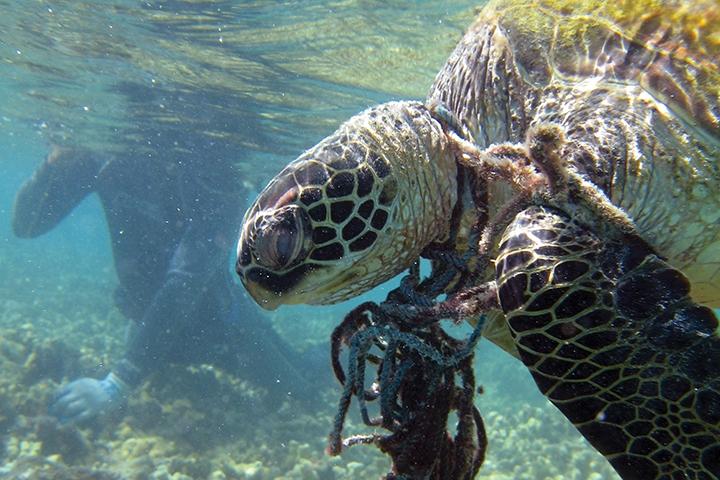Swimming in an ocean of rubbish
Marine debris continue to damage environment
December 18, 2015
Pristine blue waves roll lazily off the west coast of the United States. The Pacific Ocean hosts a variety of beautiful wildlife, from seals to turtles, that thrive in the aquatic habitat. At least until the pristine waves give way to a sea of twisted plastic, fishing nets and microscopic contaminants. At this point the ocean currents merely smash the distorted water bottles, food wrappers with half decayed meals attached, destroyed computer monitors or electronics and other discarded or rotting waste expelled from the continents into a festering vortex of revolting pollutants. Perhaps a casual observer finds himself lucky enough to spot some of the local wildlife being ensnared by the clutches of the debris.
This drastic change occurs when a sea-faring vessel struggles to drive through the mass of rubbish and reaches the Great Pacific Garbage Patch, which spans across the Pacific Ocean from Japan to the west coast of the U.S. Broken into two sections, the Eastern Garbage Patch and the Western Garbage Patch, this collection of pollution forms a massive threat to the health of the planet and its inhabitants.
Formed by the currents created by the colliding of warm water from the south Pacific and the cold water from the Arctic ocean, the Great Pacific Garbage Patch is an amalgamation of trash, litter and abandoned equipment that is swept together to form large masses of pollutants. These areas of contamination largely consist of plastics, and according to a study conducted by the University of Georgia, an estimated 8 million tons of the substance enter the ocean each year.
However, the pollution isn’t just surface deep. Besides the discarded remains of plastics, litter and derelict fishing equipment floating on the surface of the water, microplastics are also an issue.
These plastic molecules are very difficult to clean out of the water, but are extremely dangerous to wildlife. Often mistaking plastics for food, animals such as turtles will consume trash and later starve or suffocate, being unable to digest the material.
To prevent the destruction of the Earth’s ocean and lake ecosystems, the National Oceanic and Atmospheric Administration (NOAA) continually works on its Marine Debris Program. This extensive program includes debris prevention and removal projects to simply educating people about the issue and impact on the environment.
While the NOAA works on the Great Pacific Garbage Patch, it also works much closer to home: the Great Lakes.
“Marine debris is one of the greatest man-made threats that our oceans and Great Lakes face today,” regional coordinator of the Marine Debris Program, Sarah Lowe said. “Each type of marine debris comes with its own unique challenges and questions, and we are working with the community to better understand the issue in an ever-changing global environment.”
While Stockbridge is a small community, the choices it makes affect the environment substantially.
“Plastic is the most common type of marine debris found around the world, and is therefore a big problem,” Lowe said. “Much of the plastic we use every day are single-use, disposable items. They are meant to be used once and thrown away! Unfortunately, that leaves us with a lot of waste that can be littered or not recycled and then can end up in our lakes and oceans. And remember, we’re all upstream. So, even if it does end up at a landfill, it could blow away or get washed into the nearest river and out to our lakes, and eventually even the ocean.”
Though, even small communities contribute to the pollution, they can also prevent it.
“Everyone can be part of the solution,” Lowe said. “One important way we prevent marine debris is to educate people and increase awareness about the issue. We can also encourage people to practice the three R’s: reduce the amount of waste you produce, reuse items when you can and choose reusable items over disposable ones and recycle as much as possible.”
Stockbridge leadership students have taken the initiative for 10 years with their recycling program at the school.
“We’ve got a big change this year,” leadership teacher Corey Baird said. “Granger, who is who we go through, they brought us bins this year. So now we can use our bags until they fall apart, then roll these bins down the hallway. That reduces the paper waste we put out.”
Lowe also mentioned that community cleanups are a great way to help, in addition to the programs already in place.
“Encourage the community to participate in cleanups, and help us record the information using the Marine Debris Tracker App,” Lowe said. “In this sense we are combining two potential solutions, both educating people on the issue and helping to clean it up!”

